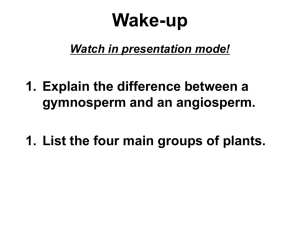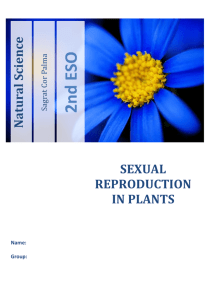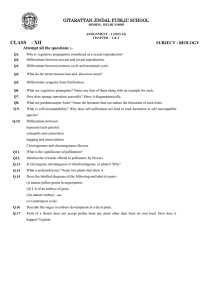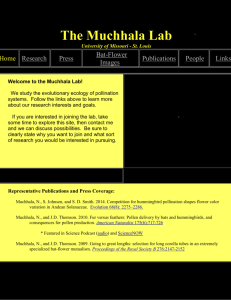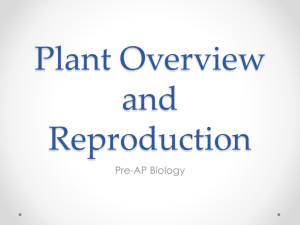EVIDENCE FOR WIND-MEDIATED, SELF AND CROSS MEDITERRANEAN ENVIRONMENTS
advertisement
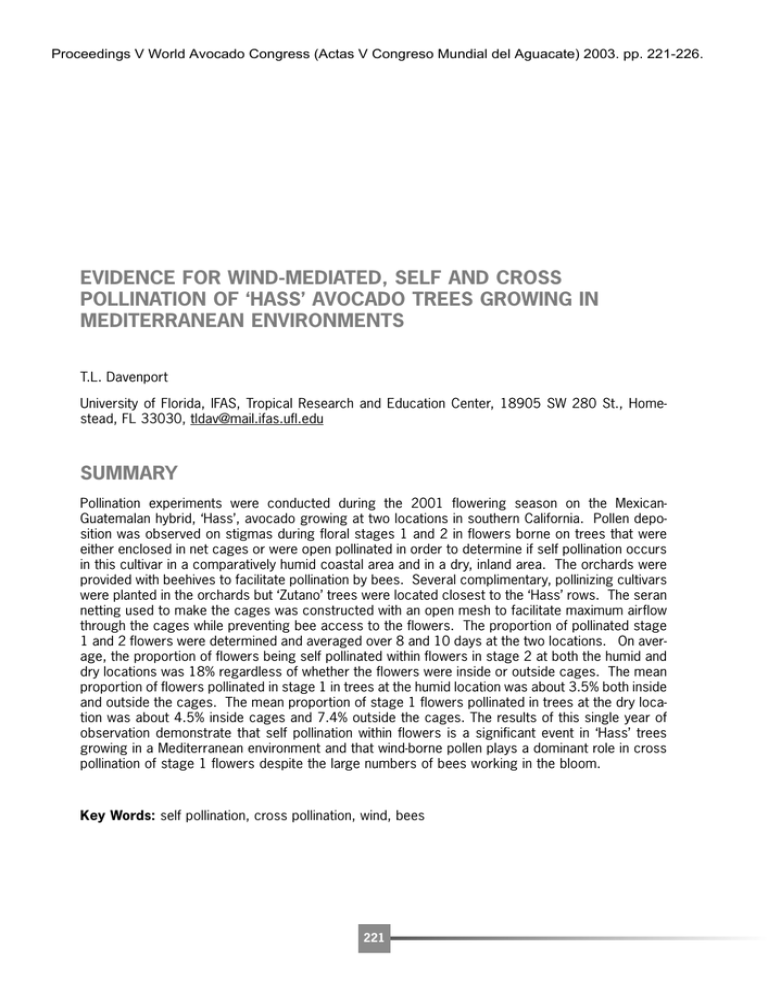
Proceedings V World Avocado Congress (Actas V Congreso Mundial del Aguacate) 2003. pp. 221-226. EVIDENCE FOR WIND-MEDIATED, SELF AND CROSS POLLINATION OF ‘HASS’ AVOCADO TREES GROWING IN MEDITERRANEAN ENVIRONMENTS T.L. Davenport University of Florida, IFAS, Tropical Research and Education Center, 18905 SW 280 St., Homestead, FL 33030, tldav@mail.ifas.ufl.edu SUMMARY Pollination experiments were conducted during the 2001 flowering season on the MexicanGuatemalan hybrid, ‘Hass’, avocado growing at two locations in southern California. Pollen deposition was observed on stigmas during floral stages 1 and 2 in flowers borne on trees that were either enclosed in net cages or were open pollinated in order to determine if self pollination occurs in this cultivar in a comparatively humid coastal area and in a dry, inland area. The orchards were provided with beehives to facilitate pollination by bees. Several complimentary, pollinizing cultivars were planted in the orchards but ‘Zutano’ trees were located closest to the ‘Hass’ rows. The seran netting used to make the cages was constructed with an open mesh to facilitate maximum airflow through the cages while preventing bee access to the flowers. The proportion of pollinated stage 1 and 2 flowers were determined and averaged over 8 and 10 days at the two locations. On average, the proportion of flowers being self pollinated within flowers in stage 2 at both the humid and dry locations was 18% regardless of whether the flowers were inside or outside cages. The mean proportion of flowers pollinated in stage 1 in trees at the humid location was about 3.5% both inside and outside the cages. The mean proportion of stage 1 flowers pollinated in trees at the dry location was about 4.5% inside cages and 7.4% outside the cages. The results of this single year of observation demonstrate that self pollination within flowers is a significant event in ‘Hass’ trees growing in a Mediterranean environment and that wind-borne pollen plays a dominant role in cross pollination of stage 1 flowers despite the large numbers of bees working in the bloom. Key Words: self pollination, cross pollination, wind, bees 221 V Congreso Mundial del Aguacate INTRODUCTION Avocados grown in south Florida are primarily self pollinated by pollen transfer within flowers during the stage 2 floral opening (Davenport, 1989; Davenport et al., 1994). There has also been reason to consider that wind may be an important vector for transfer of dispersed pollen to nearby flowers of complimentary cultivars during stage 1 floral openings (Davenport, 1998). Moreover, deposition of pollen from either the same or a different cultivar during stage 2 has been demonstrated to reach the egg apparatus by 48 hrs after pollination (Davenport, 1999). In contrast, research results in Israel has led to the conclusion that cultivars grown in Mediterranean climates are not self pollinated due in large extent to the fact that stigmas are dry and no longer receptive to pollen during stage 2 floral openings or that conditions in pollinated styles do not facilitate pollen tube growth (Gazit and Degani, 2002). Bees or some other pollinator are, thus, required for pollen transfer to stage 1 flowers between complimentary cultivars. Gazit and Degani (2002) recently reviewed the subject of avocado pollination and concluded that the reported success of self pollination in Florida was due to the use of ‘tropical” cultivars in warm, humid climates whereas the floral behavior of cultivars containing Mexican race genes are better adapted to cool, dry Mediterranean conditions with little opportunity for self pollination and should be classified as “subtropical” cultivars. The objectives of this study during the 2001 avocado flowering season were to estimate the proportion of cross- vs. self-pollination of ‘Hass’ flowers in orchards located in either humid or dry Mediterranean climates of southern California through examination of pollen deposition times and to examine possible mobility of pollen in air as related to wind-mediated, cross- & self-pollination vs. bee pollination of flowers. MATERIALS AND METHODS Two commercial orchards were chosen in Ventura County, California to represent humid and dry conditions respectively. Site 1 was located on the coastal plain near Oxnard, and Site 2 was located inland in the dry hills near Fillmore. Sixty beehives, half housing Italian and half housing New World Carniolan bees, were provided in the Site 1 orchard about 100 meters from the experimental trees. An unknown number of beehives were placed in the Site 2 orchard by the grower. Four caged ‘Hass’ trees standing 6 to 8 ft high and their in-row partners were tagged for this experiment at each location. All trees were in a row located adjacent to the complimentary cultivar, ‘Zutano’, a “B” type cultivar. Cages (10 ft3) were constructed of 40 % LENO/LOCK shade cloth (Style #10419, TC Baycor) supported by 3/4 inch PVC pipe frames in order to completely cover the caged trees without touching the inflorescences. The size of the openings in the cloth matrix was 2x4 mm, which was sufficient to prevent honeybee penetration but large enough to allow unrestricted passage of wind and pollen, if present. Open seams in the corners of the cages were tightly sealed with duct tape and closely monitored for any possible entry of bees. None were ever found inside any cage at any time during the course of observations. One to two hundred flowers were collected from ‘Hass’ trees at the end of stage 1 (female phase) and stage 2 (male phase) floral openings on the days of observation at each site to determine the amount of pollen deposition in each stage. Flowers were stored in a solution composed of 75% ethanol, 25% glacial acetic acid until they could be dissected. Styles were excised from the individual flowers and mounted in groups of 25 each on slides layered with a staining gel described by Davenport (1989). Stigmas were then observed directly under transmission light microscope for the presence or absence of germinated pollen. The results were averaged by floral stage, treatment tree, date, and location and subjected to ANOVA and Student’s T test where appropriate. 222 Floración y fructificación The times of stages 1 and 2 floral openings and closings of ‘Hass’ flowers as well as dehiscence times and pollen release times of stage 2 flowers in ‘Zutano’ were also recorded to determine the incidence of overlap of floral openings that could result in close pollination and the possible availability of windborne pollen during ‘Hass’ stage 1. Self-pollination takes place only in stage 2 flowers that still have white stigmas at the time of pollen dispersal. The proportion of white stigmas were, thus, monitored each day by counting the number of white stigmas in each of three replicate counts of 100 flowers at the close of stages 1 and 2. RESULTS AND DISCUSSION More than 20,000 flowers were collected at the ends of stages 1 and 2 inside and outside the cages at the two sites during the 2001 flowering season. Each flower was observed for the presence or absence of pollen, and the number of pollen grains on each stigma was tallied. The data collected across the span of the flowering season was averaged daily and reported as the percent of observed flowers that bore at least one pollen grain in each floral stage of inflorescences inside and outside of the cages at the humid Site 1 (Table 1) and the dry Site 2 (Table 2). There appeared to be about the same amount of pollen deposition occurring in stage 2 (self pollination) both inside and outside the cages at both sites as what we have observed in cultivars growing in south Florida (Davenport et al., 1994). The range of stage 2 flowers being self-pollinated, thus, appeared to be about 10 to 35 %, averaging nearly 19% for the season in the two orchard sites (Tables 1 and 2). The proportion of white stigmas present for self-pollination in stage 2 (Table 3) was far greater than the proportion of self-pollination occurring in stage 2 (Tables 1 and 2). The proportion of flower stigmas receiving pollen in stage 1 (cross pollination) averaged about 4 to 8 % depending on location. There was no consistent or significant difference in the amount of pollination in stage 1 inside vs. outside the bee-proof cages at the Site 1 orchard fortified with 60 hives of honeybees (Table 1). This result suggests that, although the bees were observed to be aggressively working the flowers, little pollen transfer was taking place. There was a significant difference in cross-pollination rates among trees inside vs. outside the cages at the Site 2 orchard, suggesting that bees may have been more affective at that location (Table 2). Seventy to 90 percent of the pollinated stigmas showed only one pollen grain when observed in either stage at either location (Figs 1 and 2). The remaining proportion was distributed among stigmas receiving 2 or more pollen grains. There were no meaningful differences in numbers of pollen grains per stigma between flowers inside or outside cages. Clearly, bees did not contribute to stage 1 pollination inside the cages. The possibility that pollen was transported in the wind from complimentary stage 2 ‘Zutano’ flowers to the stage 1 ‘Hass’ best fits the observed pollination patterns. The amount of stage 1 pollination outside the cages was generally higher at Site 2 but not always. Thus, it is unclear from these few days of observation what the contribution of bees was to pollination in the open. Other sources of stage 1 pollination could come from overlap of floral openings within inflorescences allowing abiotic pollen transfer from stage 2 to stage 1 flowers. We observed few days of floral overlap during the study. Cool temperatures most often delayed both floral openings with no overlap. No overlap occurred on the observation days reported in Tables 1 and 2. The range of apparent self-pollination rate observed inside and outside cages at the two locations was about 80 to 85% of the pollinated flowers for the season. These proportions are consistent with the findings of 60 to 80% self pollinated mature fruit observed by Kobayashi et al. (2000) and clearly demonstrate that successful self pollination by pollen transfer within flowers occurs in California ‘Hass’ avocados, hence the source of good production in large, solid block plantings. 223 V Congreso Mundial del Aguacate CONCLUSION Results from the 2001 flowering season indicate the strong probability that self-pollination is a major component of fruit set in both humid and dry Mediterranean environments and that pollen can be transferred to Stage 1 flowers without honeybees. The only logical explanation for all of the observed results is that wind was the primary pollination vector for avocados at both locations. Wind currents could, thus, carry the pollen from complimentary, stage-2 ‘Zutano’ flowers through the mesh of the cages to stage 1 ‘Hass’ flowers inside as well as outside the cages. This is not to discount the importance of honeybees in pollination of avocado flowers; however, other factors clearly impact yield in California. Observation of the caged trees in the 2001 California experiments revealed little fruit set in them compared to adjacent non-caged test trees, which set a good crop. Clearly the type and timing of pollen deposition was not the cause of lack of fruit set inside cages since all aspects of pollination were identical in both sets of trees. Other factors present during and after pollination was the apparent cause of lack of fruit set. The most logical explanation is temperature differences inside and outside the cages. Acknowledgements The author wishes to thank Brad Meiners for technical assistance in the field, Juanita Sanchez for technical support analyzing flower samples, A. Elizabeth Fetscher for providing and maintaining beehives and recording temperature data, and Mary Lu Arpeia for her assistance in selecting avocado orchards best suited for conducting the experiments, and the owners of those orchards for their support of the research activities. This research was supported by the California Avocado Commission. Florida Agricultural Experiment Station Journal Series No. ______. REFERENCES DAVENPORT T L 1989 Pollen deposition on avocado stigmas in Southern Florida. HortScience 24:844-845. DAVENPORT TL 1998 What if there is no pollinator? Subtropical Fruit News 6:15-17. DAVENPORT TL 1999 A view from Florida on avocado pollination. In: ML Arpaia and R Hofshi (eds) Proceedings of Avocado Brainstorming ’99. California Avocado Commission and College of Natural and Agricultural Sciences, University of California, Riverside, pp 101-104. DAVENPORT TL, PARNITZKI P, FRICKE S, HUGHES MS 1994 Evidence and significance of self-pollination of avocados in Florida. Journal of the American Society for Horticultural Science 119:12001207. GAZIT S, DEGANI C. 2002 Reproductive Biology. In: Wiley T, Schafer B, Wolstenholme BN (eds) The Avocado: Botany, Production, and Uses. CABI Publishing, Wallingford Oxen, UK pp 101-133. KOBAYASHI M, LIN J-Z, DAVIS J, FRANCIS L, CLEGG MT 2000 Quantitative analysis of avocado outcrossing and yield in California using RAPD markers. Scientia Horticulturae 86:135-149. 224 Floración y fructificación Table 1. Pollination summary at Site 1 orchard. Daily Average % Pollination Inside Date 4/18 4/26 4/27 4/30 5/1 5/2 5/3 5/4 Ave. Corrected** Stage 1 4.98 2.10 3.00 2.14 4.79 3.40 Outside Stage 2 30.28 21.40 37.01 13.77 17.68 11.77 21.98 18.58 Stage 1 3.41 3.91 2.92 3.95 1.85 6.30 3.72 Stage 2 33.61 18.36 36.28 15.18 14.76 17.00 22.53 18.81 * significantly different (P=.0506) ** Pollen deposited in stage 1 are those derived from complimentary cultivars (cross pollination) or from within the same ‘Hass’ trees (close pollination), the latter of which was rare and did not occur on observation days. Stage 2 observations are the culmination of both stage 1 and 2 pollen depositions; therefore the stage 1 average was subtracted from the stage 2 average (Corrected stage 2 value) to estimate the proportion of stigmas pollinated in stage 2 (self pollination). 225 V Congreso Mundial del Aguacate Table 2. Pollination summary at Site 2 orchard. Daily Average % Pollination Inside Date Stage 1 5/7 5/8 5/9 5/10 5/11 5/14 5/22 5/24 5/25 6/1 Ave. Corrected** 1.00 8.42 10.07 4.59 3.56 3.16 4.35 1.24 Outside Stage 2 Stage 1 Stage 2 6.01 12.48 9.38 5.21 10.69 5.53 5.73 7.29 20.00 29.28 26.73 26.80 43.64 29.53 18.79 21.33 15.10 18.61 24.98 17.59 25.61 28.79 20.90 24.54 20.58 23.58 29.49 16.11 19.61 23.24 18.76 3.92 4.48* 4.17 7.39* * significantly different (P=.0506) ** Pollen deposited in stage 1 are those derived from complimentary cultivars (cross pollination) or from within the same ‘Hass’ trees (close pollination), the latter of which was rare and did not occur on observation days. Stage 2 observations are the culmination of both stage 1 and 2 pollen depositions; therefore the stage 1 average was subtracted from the stage 2 average (Corrected stage 2 value) to estimate the proportion of stigmas pollinated in stage 2 (self pollination). Table 3. Proportions of white stigmas at the close of stages 1 and 2. Orchard Humid Site 1 Dry Site 2 Stage 1 % 99 97 Stage 2 % 96 53 Figure 1. Proportion of number of pollen grains observed per pollinated stigma at Site 1 (A) and Site 2 (B). B A INSIDE OUTSIDE INSIDE 1 1 STAGE 1 2 3 3 4 >4 >4 STAGE 2 4 STAGE 2 STAGE 1 2 OUTSIDE 226



